| |
|
|
55.
| Dead Language |
| |

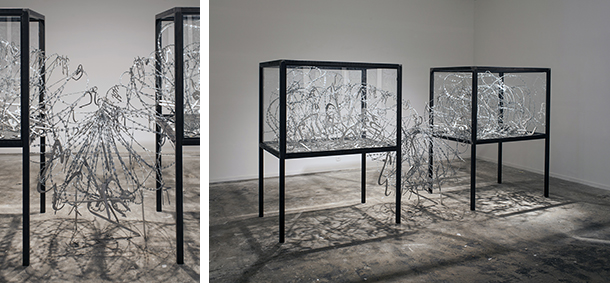
2016, Windows, barbed wire and calligraphies, 125 x 90 x 165 cm each.
Exhibition view of A Savage Mind, Keitelman Gallery, 2016, Brussels.
Courtesy of the artist and Ceysson & Bénétière, Paris.
Ed. of 5 + 1 A.P.
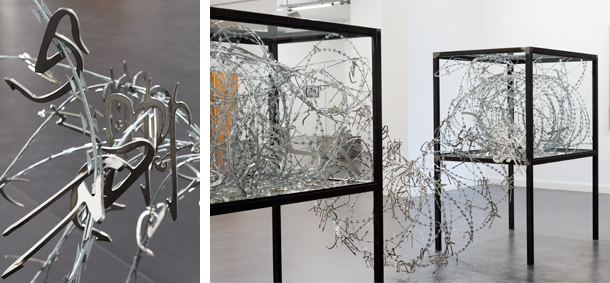
2016, Windows, barbed wire and calligraphies, 125 x 90 x 165 cm each.
Exhibition view of Depth of Field, Labanque, 2016, Béthune
Courtesy of the artist and Ceysson & Bénétière, Paris.
Ed. of 5 + 1 A.P.
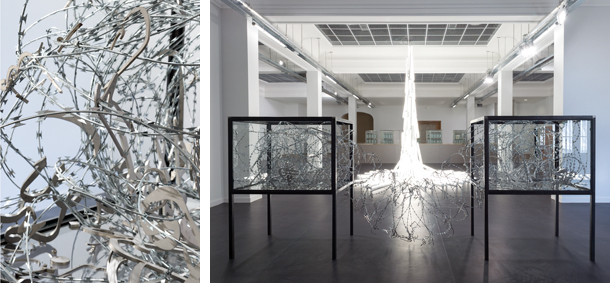
2016, Windows, barbed wire and calligraphies, 125 x 90 x 165 cm each.
Exhibition view of Depth of Field, Labanque, 2016, Béthune
Courtesy of the artist and Ceysson & Bénétière, Paris.
Ed. of 5 + 1 A.P.
“Dead Language installation expresses all the violence felt when one must abandon everything at border crossings, starting with one’s language; the very first conveyance of a person’s identity.”
Anti-utopias, January, 2017
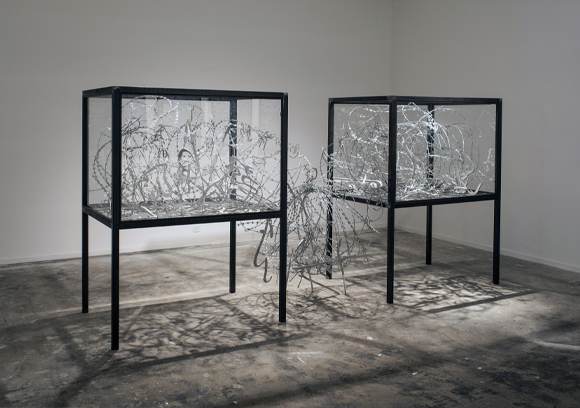
Dead Language
Exhibition view of A Savage Mind, Keitelman Gallery, 2016, Brussels.
Courtesy of the artist and Ceysson & Bénétière, Paris.
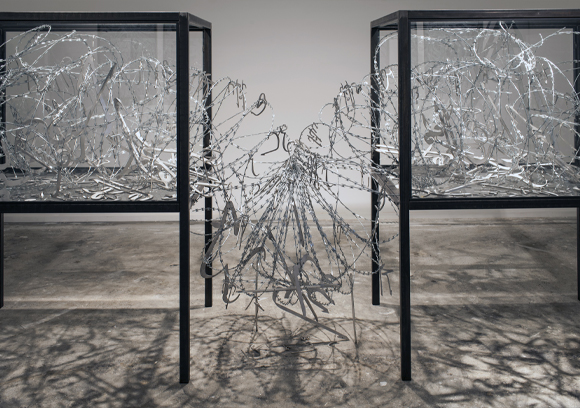
Dead Language
Exhibition view of A Savage Mind, Keitelman Gallery, 2016, Brussels.
Courtesy of the artist and Ceysson & Bénétière, Paris.

Dead Language
Exhibition view of Depth of Field, Labanque, 2016, Béthune.
Courtesy of the artist and Ceysson & Bénétière, Paris.
|
|
|
|
|
|
|
Dead Language est une installation de mounir fatmi composée d’éléments de calligraphies arabes découpés dans des plaques métalliques, du fil barbelé et de deux vitrines en verre. Réunissant ainsi trois éléments qui sortent complètement de leurs contextes habituels.
Le fil barbelé rempli l’espace vide des deux vitrines et passe de l’une à l’autre formant ainsi une frontière. Cet espace devenu infranchissable pour le public, l’oblige à reculer et appréhender l’installation dans son ensemble. Le spectateur tenu à distance par cette frontière, est aussi systématiquement invité à ne pas toucher l’œuvre.
Réflexion sur le phénomène de la perte d’une partie de son héritage et de la souffrance engendrée par cette perte, Dead Language apporte un autre regard sur la douleur de l’immigration. Cette œuvre illustre de manière universelle ce déchirement entre le corps et la langue à l’arrivée dans un nouveau pays.
Les deux vitrines de l’installation Dead Language évoque donc deux réalités. D’une part celle du pays natal et l’autre celle du pays d’accueil. Symbolisant à la fois un lien et un point de rupture, l’œuvre met en avant l’aspect périlleux et douloureux du voyage. Ces mots calligraphiés, parfois ces bribes de phrases se trouvent emprisonnées, prises au piège dans le fil barbelé. Non sans rappeler les divers clichés des Checkpoint présents dans les manuels d’histoire ou encore les images de presses reflétant l’actualité tragique des flux migratoires et de déplacements. Evoquant donc cette notion de frontière, le fil barbelé évoque une réalité douloureuse, celle du déracinement. Périple douloureux, l’arrivée dans un nouveau pays engendre souvent un sentiment de déracinement, voire d’amputation d’un membre tels les éléments épars de calligraphies.
L’installation Dead Language peut alors s’apparenter à un reliquaire où sont conservées des brides d’un héritage culturel. Précieuses, ces reliques permettent de passer outre le sentiment de sortie de soi engendré par l’abandon de cette langue natale. Mais ce sentiment d’obsolescence, rendu urgent par la nécessité d’acquérir une nouvelle langue, semble formuler un rite de passage douloureux et violent mais qui ouvre sur un nouvel espace à investir.
Mais finalement sommes-nous tous égaux devant cette possibilité de déplacement ?
Studio Fatmi, novembre 2016.
|
|
Dead Language is an installation by mounir fatmi composed of elements of Arabic calligraphy cut out from metal plates, barbed wire and two glass showcases. Three elements, completely removed from their usual context, are brought together. The barbed wire fills the empty space between the two showcases and forms a border between them. This space becomes impenetrable for the viewer and requires him or her to step back and appreciate the installation as a whole. The spectator is held at a distance by this frontier and is methodically invited to not touch the work.
Reflecting on the loss of part of one’s heritage and the suffering engendered by this deprivation, Dead Language brings the pain of immigration into focus. This work illustrates the universal way in which the body and language are torn apart upon arrival in a new country.
The two showcases in the Dead Language installation evoke two realities: the native country and the host country. Symbolizing both a link and a breaking point, the work highlights the perilous and painful aspect of the journey. These calligraphic and sometimes fragmented sentences are imprisoned, trapped in the barbed wire. The work does not fail to recall the various clichés of checkpoints present in history textbooks, or even the journalistic images of the tragic actuality of streams of migration and displacement.
In evoking this notion of frontiers, the barbed wire symbolizes the aching reality of uprooting. After an agonizing journey, the arrival in a new country often creates a feeling of displacement comparable to the amputation of a limb, mirrored in the scattered elements of calligraphy.
The Dead Language installation can be likened to a reliquary storing bridles of cultural inheritance. These priceless relics allow us to overcome the feeling of leaving oneself behind as the native language is abandoned. This sense of obsolescence is made urgent by the need to acquire a new language and it seems to usher in a painful and violent rite of passage, but it in fact opens up a new opportunity for investment.
But are we all equal when faced with this possibility of displacement ?
Studio Fatmi, December 2016.
|
|
|
|